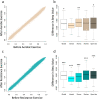Resistance and aerobic training increases genome-wide DNA methylation in women with polycystic ovary syndrome
- PMID: 38245873
- PMCID: PMC10802204
- DOI: 10.1080/15592294.2024.2305082
Resistance and aerobic training increases genome-wide DNA methylation in women with polycystic ovary syndrome
Abstract
Physical activity is a first-line treatment for polycystic ovary syndrome (PCOS). Resistance or aerobic exercise improves metabolic complications, reproductive outcomes, and quality of life in PCOS. DNA methylation reprogramming during exercise may be the major modifier behind these changes. We sought to evaluate genome-wide DNA methylation changes after supervised resistance and aerobic exercise in women with PCOS. Exercises were performed in 56 women with PCOS (resistance, n = 30; aerobic, n = 26), for 16 weeks (wks), three times per week, in 50-minute to one-hour sessions. Anthropometric indices and hormonal and metabolic parameters were measured before and after training. Genome-wide leukocyte DNA methylation was analysed by Infinium Human MethylationEPIC 850K BeadChip microarrays (Illumina). Both resistance and aerobic exercise improved anthropometric indices, metabolic dysfunction, and hyperandrogenism in PCOS after the training programme, but no differences were observed between the two exercises. Resistance and aerobic exercise increased genome-wide DNA methylation, although resistance changed every category in the CpG island context (islands, shores, shelve, and open sea), whereas aerobic exercise altered CpG shores and the open sea. Using a stringent FDR (>40), 6 significantly differentially methylated regions (DMRs) were observed in the resistance exercise cohort and 14 DRMs in the aerobic cohort, all of which were hypermethylated. The increase in genome-wide DNA methylation may be related to the metabolic and hormonal changes observed in PCOS after resistance and aerobic exercise. Since the mammalian genome is hypermethylated globally to prevent genomic instability and ageing, resistance and aerobic exercise may promote health and longevity through environmentally induced epigenetic changes.
Keywords: DNA methylation; Polycystic ovary syndrome; aerobic training; physical activity; resistance training.
Conflict of interest statement
The authors declare that the research was conducted in the absence of any commercial or financial relationships that could be construed as a potential conflict of interest.
Figures




Similar articles
-
Comparison of the Effect of Intermittent and Continuous Aerobic Physical Training on Sexual Function of Women With Polycystic Ovary Syndrome: Randomized Controlled Trial.J Sex Med. 2018 Nov;15(11):1609-1619. doi: 10.1016/j.jsxm.2018.09.002. Epub 2018 Oct 11. J Sex Med. 2018. PMID: 30316737 Clinical Trial.
-
Genome-wide screen of ovary-specific DNA methylation in polycystic ovary syndrome.Fertil Steril. 2015 Jul;104(1):145-53.e6. doi: 10.1016/j.fertnstert.2015.04.005. Epub 2015 May 5. Fertil Steril. 2015. PMID: 25956362
-
Comprehensive analysis of genome-wide DNA methylation across human polycystic ovary syndrome ovary granulosa cell.Oncotarget. 2016 May 10;7(19):27899-909. doi: 10.18632/oncotarget.8544. Oncotarget. 2016. PMID: 27056885 Free PMC article.
-
DNA methylation in polycystic ovary syndrome: Emerging evidence and challenges.Reprod Toxicol. 2022 Aug;111:11-19. doi: 10.1016/j.reprotox.2022.04.010. Epub 2022 May 10. Reprod Toxicol. 2022. PMID: 35562068 Review.
-
Conservative treatment options for polycystic ovary syndrome: the importance of exercise.Ceska Gynekol. 2020 Winter;85(6):430-435. Ceska Gynekol. 2020. PMID: 33711904 Review. English.
Cited by
-
DNA methylation and its impact on ovarian steroidogenesis in women with polycystic ovary syndrome: insights from human and animal models.Arch Gynecol Obstet. 2025 Aug;312(2):363-374. doi: 10.1007/s00404-025-08048-w. Epub 2025 May 23. Arch Gynecol Obstet. 2025. PMID: 40407877 Free PMC article. Review.
-
The Role of DNA Methylation in Insulin Resistance and Metabolic Dysregulation in Polycystic Ovary Syndrome Patients: A Systematic Review.Cureus. 2025 May 17;17(5):e84279. doi: 10.7759/cureus.84279. eCollection 2025 May. Cureus. 2025. PMID: 40525011 Free PMC article. Review.
-
Applicability of epigenetic age models to next-generation methylation arrays.Genome Med. 2024 Oct 7;16(1):116. doi: 10.1186/s13073-024-01387-4. Genome Med. 2024. PMID: 39375688 Free PMC article.
-
The Impact of the COVID-19 Pandemic on Health and Health Care Experience in Those With Polycystic Ovary Syndrome.Int J Womens Health. 2025 Feb 4;17:287-298. doi: 10.2147/IJWH.S504439. eCollection 2025. Int J Womens Health. 2025. PMID: 39925784 Free PMC article.
-
Molecular Effects of Physical Activity and Body Composition: A Systematic Review and Meta-Analysis.Int J Environ Res Public Health. 2025 Apr 18;22(4):637. doi: 10.3390/ijerph22040637. Int J Environ Res Public Health. 2025. PMID: 40283858 Free PMC article.
References
MeSH terms
Substances
LinkOut - more resources
Full Text Sources
Other Literature Sources
Medical
Molecular Biology Databases
